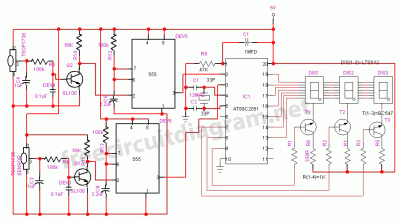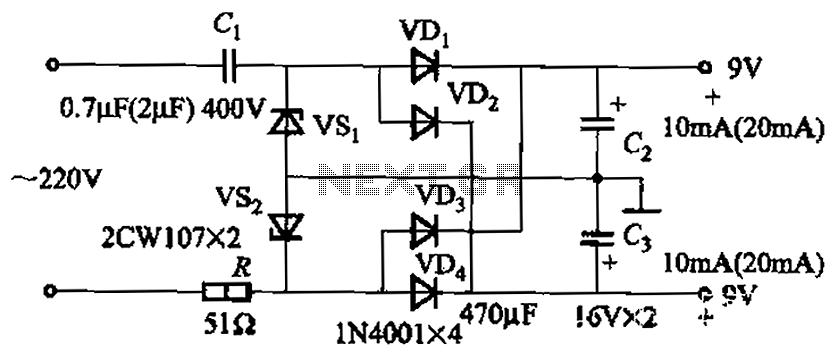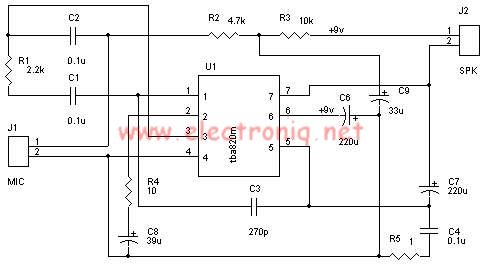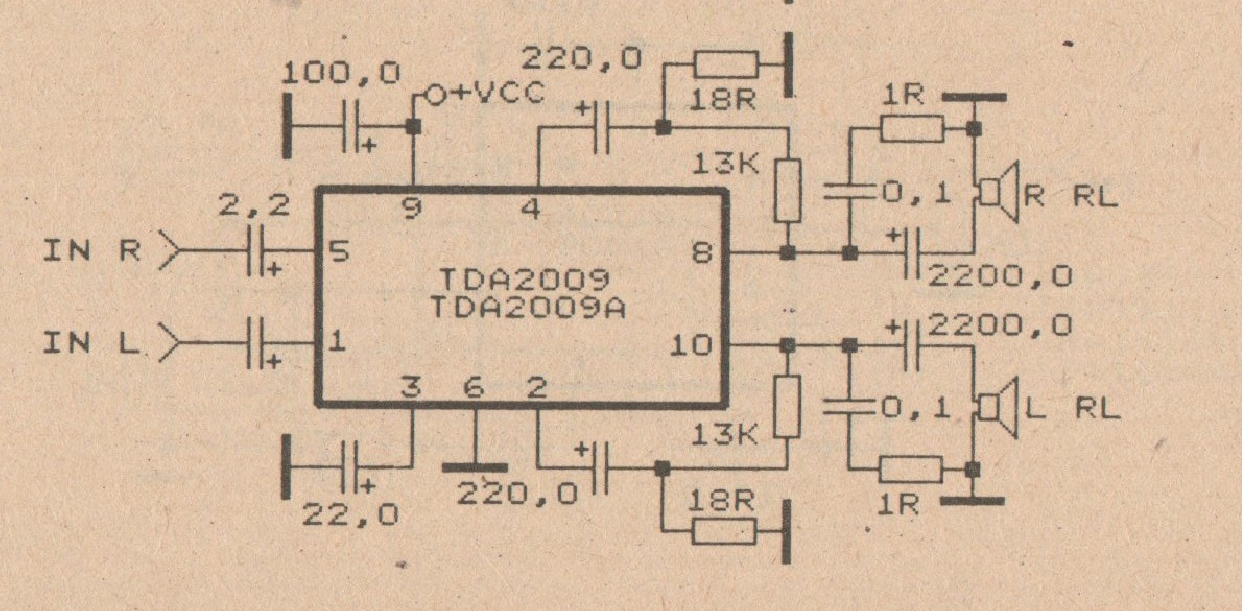
Bridge the digital pressure signal conditioner MAX1458 excitation circuit diagram
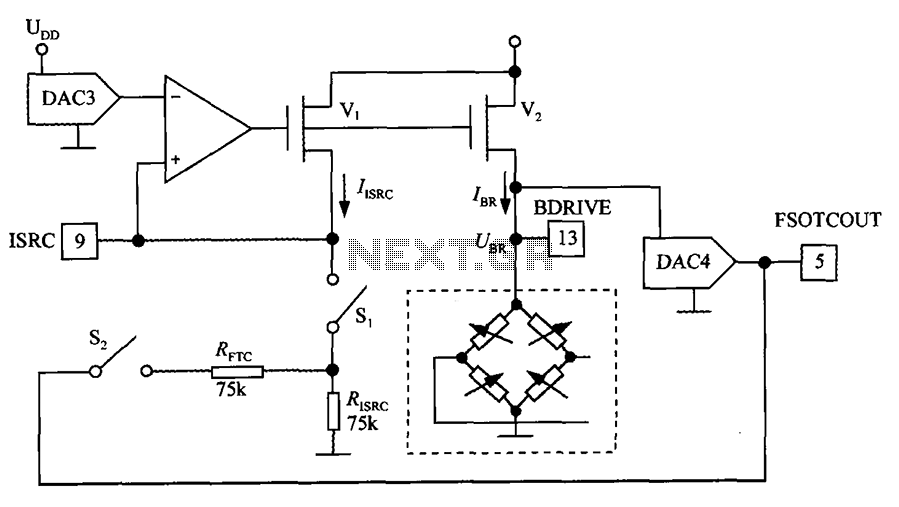
The excitation circuit for the digital pressure signal conditioner MAX1458 is illustrated. The output DAC3 is utilized to adjust the sensor excitation current (IBR), enabling full-scale fine calibration. The reference current (IISRC) is determined by the resistor RISRC and the voltage at pin 9. A current mirror formed by components V1 and V2 provides a current gain of 14 times, allowing the excitation current IBR to be set at 14 times IISRC. The programming range for IBR is from 0.1 mA to 2 mA. The on-off states of analog switches S1 and S2 are controlled by configuration registers. When the full-scale output voltage varies, DAC3 compensates by adjusting the output voltage (BR), thereby rectifying the full-scale error. DAC4 is employed to correct errors related to the full-scale temperature coefficient.
The excitation circuit of the MAX1458 digital pressure signal conditioner is designed to facilitate precision control of the excitation current supplied to the sensor. The architecture includes a digital-to-analog converter (DAC3), which plays a critical role in modulating the sensor excitation current (IBR) to achieve accurate calibration across the full scale. The reference current (IISRC) is established by the resistor RISRC, with the voltage at pin 9 influencing its value.
The current mirror configuration, comprising V1 and V2, is engineered to amplify the reference current by a factor of 14, thereby allowing the excitation current IBR to be programmed within a specified range of 0.1 mA to 2 mA. This capability is essential for adapting the excitation current to the specific requirements of various sensor applications, ensuring optimal performance.
The circuit employs analog switches S1 and S2, which are controlled through configuration registers, enabling selective activation of the excitation current path. This flexibility is crucial for dynamic system adjustments and operational efficiency.
Furthermore, the compensation mechanism for variations in full-scale output voltage is integrated within DAC3. As the output voltage fluctuates, DAC3 adjusts the output voltage (BR) accordingly, effectively correcting any full-scale errors that may arise. This feedback loop enhances the accuracy of the pressure measurement system.
Additionally, DAC4 is incorporated to address temperature-related errors in the full-scale output. By compensating for the temperature coefficient, DAC4 ensures that the system maintains its accuracy across varying thermal conditions, further solidifying the reliability of the MAX1458 digital pressure signal conditioner in diverse applications. Bridge the digital pressure signal conditioner MAX1458 excitation circuit is shown. Using the output DAC3 to change the size of the sensor excitation current IBR, you can achie ve full-scale fine calibration. IISRC reference current by RISRC and 9-pin voltage is set. V1 and V2 composed of current mirror, the current gain of 14 times, allow the excitation current IBR 14IISRC. IBR programming range is 0.1 ~ 2mA. Analog switches S1, S2 on-off state governed by the configuration registers. Obviously, when the full-scale output voltage changes, DAC3 bridge will be compensated by changing the output voltage, BR, thereby correcting the full-scale error.
DAC4 full scale temperature coefficient for correcting errors.
The excitation circuit of the MAX1458 digital pressure signal conditioner is designed to facilitate precision control of the excitation current supplied to the sensor. The architecture includes a digital-to-analog converter (DAC3), which plays a critical role in modulating the sensor excitation current (IBR) to achieve accurate calibration across the full scale. The reference current (IISRC) is established by the resistor RISRC, with the voltage at pin 9 influencing its value.
The current mirror configuration, comprising V1 and V2, is engineered to amplify the reference current by a factor of 14, thereby allowing the excitation current IBR to be programmed within a specified range of 0.1 mA to 2 mA. This capability is essential for adapting the excitation current to the specific requirements of various sensor applications, ensuring optimal performance.
The circuit employs analog switches S1 and S2, which are controlled through configuration registers, enabling selective activation of the excitation current path. This flexibility is crucial for dynamic system adjustments and operational efficiency.
Furthermore, the compensation mechanism for variations in full-scale output voltage is integrated within DAC3. As the output voltage fluctuates, DAC3 adjusts the output voltage (BR) accordingly, effectively correcting any full-scale errors that may arise. This feedback loop enhances the accuracy of the pressure measurement system.
Additionally, DAC4 is incorporated to address temperature-related errors in the full-scale output. By compensating for the temperature coefficient, DAC4 ensures that the system maintains its accuracy across varying thermal conditions, further solidifying the reliability of the MAX1458 digital pressure signal conditioner in diverse applications. Bridge the digital pressure signal conditioner MAX1458 excitation circuit is shown. Using the output DAC3 to change the size of the sensor excitation current IBR, you can achie ve full-scale fine calibration. IISRC reference current by RISRC and 9-pin voltage is set. V1 and V2 composed of current mirror, the current gain of 14 times, allow the excitation current IBR 14IISRC. IBR programming range is 0.1 ~ 2mA. Analog switches S1, S2 on-off state governed by the configuration registers. Obviously, when the full-scale output voltage changes, DAC3 bridge will be compensated by changing the output voltage, BR, thereby correcting the full-scale error.
DAC4 full scale temperature coefficient for correcting errors.
